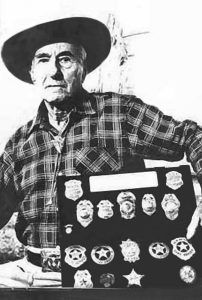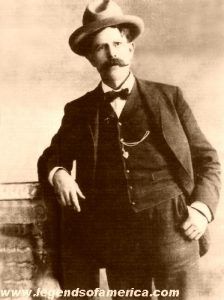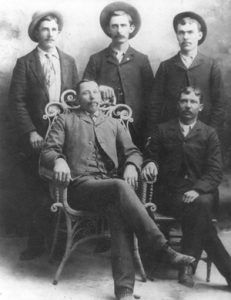Lawman Summaries (name begins with) A B C D E F G H I J K L M N O P Q R S T U V W X Y Z
Charles Frederick “Kid” Lambert (1887-1971) – After bringing in three killers at the age of 16, he was made the youngest Territorial Marshall from New Mexico. He was later appointed to the New Mexico Mounted Police and pursued the Wild Bunch and Black Jack Ketchum’s Gang. Afterward, he was made a U.S. Special Officer and continued to serve as a lawman until after WWII.
Peter R. “Rattlesnake Pete” Lanahan (18??-1871) – In 1861, Lanahan was employed by the Quartermaster’s Department at Fort Hays, Kansas. On February 22, 1868, he was hired as a city policeman for the newly incorporated Hays City, a position he held until August when he returned to Fort Hays. In August 1869, he went to work for James B. “Wild Bill” Hickok as a deputy, but In November, he ran against the infamous gunfighter in the Sheriff’s election. Defeating Hickok, Lanahan assumed the new position in January 1870, and Wild Bill moved on. However, some of the rowdy crowd of Hays City were none too happy at the replacement and soon began to plot an assassination. On the night of July 16, 1871, several of these assassins started a fight in the Tenth Street Saloon, knowing that Sheriff Lanahan would come running. When Lanahan arrived and tried to stop the violence, he was shot twice in the chest for his efforts. The Sheriff was then taken to his quarters in the courthouse and tended to by a doctor, but he died a couple of days later.
James David Landrum (18??-1942) – Served as a Texas Ranger before becoming a deputy sheriff of Haskell County, Texas, in 1901, and later in Abilene. He served on the Waco police force from 1912 to 1917 and later on the Dallas police force.
Van Lane – Served as a Texas Ranger in the 1890s and in 1897, helped break up a gang terrorizing San Saba, Texas.
N.P. Langford – Was known as a “law and order officer” in Montana when Sheriff Plummer was operating in Bannack.
John M. Larn (1849-1877) – Both an outlaw and lawman in Shackleford County, Texas, Larn got involved in a tough vigilante group called the Tin Hat Brigade, who eventually killed him.
James V. Latham (18??-1936) – A Texas Ranger beginning in 1880, he fought the Evans Gang and continued to serve for more than a decade. He later served as a deputy sheriff of El Paso County, Texas, as well as a lawman in New Mexico.
Oscar Latta – After serving as a Texas Ranger in the 1890s, he became a deputy sheriff in Kimble County, Texas in February 1897. He was later elected sheriff and helped defeat the Crane-Knight gang. He rejoined the Texas Rangers in 1939.
J. Tom Laughlin – Served as a Texas Ranger in 1907.
Robert Nelson Leatherwood (1844-1920) – Tucson, Arizona Mayor, and Pima County Sheriff. Captured a train robbing gang in 1883.
James Franklin “Bud” Ledbetter (1852-1937) – Ledbetter was born and raised in Madison, Arkansas, where he began his career as a lawman. He served as a deputy sheriff in Johnson County for ten years, gaining a reputation as a fierce fighter who was hard on thieves and killers. He moved to Indian Territory in 1894, working for an express company before being recruited as a U.S. Deputy Marshal. Working under Morton Rutherford, Ledbetter quickly earned a reputation for his gunfighting skills and is credited with single-handedly bringing in four members of the train-robbing Jennings Gang. The events of his career paralleled those of Bill Tilghman, Heck Thomas, and Chris Madsen, and he has sometimes been referred to as the “fourth guardsman.” Ledbetter became the Police Chief of Muskogee, Oklahoma in 1908, a position he held for two years. He lived in Muskogee until he died in 1937.
Joseph LeFors (1865-1940) – A detective in Wyoming who fought battles with the Wild bunch, he was later appointed as U.S. Deputy Marshal.
Lon Lewis – Served briefly as a Texas Ranger in 1889 before being appointed as a U.S. Deputy Marshal in Indian Territory. Later, he became the first sheriff of Tulsa County, Oklahoma.
Ras Lewis – See Willard Erastus Christianson
William Winslow Lewis (1855-1934) – A cowboy, Lewis joined the Texas Rangers in 1874, during which he fought against the Kiowa Indians near Jacksboro, Texas.
William Sidney “Cap” Light (1863?-1893) – Deputy sheriff, Belton, Texas, Temple, Texas, and Creede, Colorado.
W.W. Lewis (18??-1934) – Served in Company D of the Texas Rangers under Captain Dan W. Roberts.
Lighthorse Police (1844-1889) – The Indian Police in Oklahoma were given the name Lighthorse by the Five Civilized Tribes when the state was still Indian Territory.
Seldon T. Lindsey (1854-19??) – Reared in Louisiana, Lindsey’s family moved to McClennan County, Texas, after his father returned from the Civil War. Upon settling down, Seldon’s father established a law practice, and in 1870, at the age of sixteen, Seldon found work as a cowboy. Over the next several years, he worked on cattle drives to the Kansas railroads. He also spent some time hunting buffalo, where he had the opportunity to meet Buffalo Bill Cody on two occasions. In 1881, he married, and the couple would eventually have eleven children. Appointed as a U.S. Deputy Marshal in 1890, he worked out of Paris, Texas, and was involved in several gunfights as he brought in outlaws for sentencing. On June 8, 1894, Lindsey and U.S. Deputy Marshal Loss Hart shot and killed Bill Dalton, the last of the Dalton Gang.
William Henry Harrison Llewellyn (1851-1927) – Commissioned as a special agent of the Department of Justice to pursue outlaw David “Doc” Middleton, which he accomplished in 1881.
Tom Logan (1861- 1906) – An “honorable” lawman in Nevada who was shot and killed on April 7, 1906, just days before his 45th birthday. The trial of Walter Barieau would involve scandalous testimony about where Logan was killed and resulted in the acquittal of his murderer. In 2011, Logan was posthumously awarded a Purple Heart and Medal of Valor by the Nye County Sheriff.
Ira Long (1842-1913) – A cowboy and stockman, Long joined the Texas Rangers in 1872, quickly advancing to lieutenant then captain. He was involved in several Indian Battles and captured several outlaws before he left the Ranger service in 1880.
John Long aka Rivers – Deputized during New Mexico’s Lincoln County War for a raid upon the McSween house on July 19, 1878.
Steve Long, aka Big Steve – A lawman and outlaw, Long ran the “Bucket of Blood” saloon in Laramie City, Wyoming, and appointed himself assistant marshal. Long and his two partners were lynched on October 28, 1868.
James J. Longrell – Chief of the Indian Police at the San Carlos, Arizona Apache Agency in 1880.
A.W. Loomis – Served as a U.S. Deputy Marshal in New Mexico Territory.
H.W. Loomis – Served as a chief U.S. Deputy Marshal in New Mexico Territory and killed train robber Cole Estes on October 2, 1896.
Willis Anson Loomis (1860-1952) – Served as the city marshal at Leadville, Colorado, in 1886 before working at the Colorado Penitentiary in Canyon City. He also worked as a detective in Denver, Colorado, and as Chief of Police in Everett, Washington and Venice, California.
Harry Love (1809-1868) – Love was the head of California’s first law enforcement agency, the California Rangers, and became famous for allegedly killing the notorious bandit Joaquin Murrieta.
H.M. Love – While serving as a U.S. Deputy Marshal in New Mexico, he was wounded while pursuing outlaw Samuel Ketchum on July 16, 1899.
Thomas D. Love (1862-1934) – A cattleman, Love was elected as the first sheriff of Bordon County, Texas in 1890. He arrested the notorious outlaw Bill Cook, in 1895
Doctor Lozier – Served as a Texas Ranger in 1896.
Captain Louis J. Lull, aka: W.J. Allen (18??-1874) – A Pinkerton Agent from Chicago, Illinois, Lull was working with fellow Pinkerton Agent James Boyle and local St. Claire County, Missouri deputy sheriff, Edwin Daniels, searching for the elusive Younger brothers, who were thought to be in the area. On March 16, 1874, they set out from Osceola to Roscoe, Missouri. After spending the night at the Roscoe House Hotel, they left the day for the home of Theodrick Snuffer, a family friend of the Youngers, some three miles out of town. Posing as cattle buyers, they questioned Snuffer but got nowhere. Little did they know that John and Jim Younger were watching from Snuffer’s attic. When the lawmen left, the two Younger Brothers followed and ordered the three men to halt. Panicked, Pinkerton Agent James Wright spurred his horse and kept ongoing. However, the other two lawmen, Pinkerton Agent Lull and Daniels stopped, and within no time, a gunfight ensued. When the smoke cleared, John Younger and Deputy Edwin Daniels were dead, Louis Lull was severely wounded, and Jim Younger received a flesh wound in his hip. Lull was taken to Roscoe for treatment but would die of his wounds a few days later.
© Kathy Alexander/Legends of America, updated November 2022.
Also See:
Adventures in the American West
Lawman Summaries (name begins with) A B C D E F G H I J K L M N O P Q R S T U V W X Y Z



